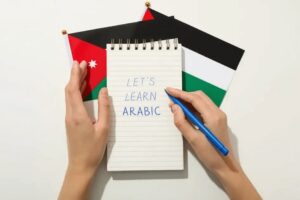
Method of Words in Arabic
Learning Arabic as a total beginner is like exploring a puzzle built from just a few pieces. Arabic words are made from root letters, patterns, and affixes—simple building blocks that combine to create thousands of words. By understanding this system, you don’t learn individual words one by one—you learn how they are created. This makes it much easier to learn Arabic, speak Arabic, and feel confident when you learn any language.
Table of Contents
ToggleWhy Understanding Arabic Word Construction Matters
When you start learning Arabic words without patterns, you memorize each word separately. But if you learn root letters and how patterns and affixes transform them, you suddenly unlock dozens of words at once. A few building blocks can give you the number of words you know quickly, help you think like a native speaker, and improve your Arabic speaking much faster.
The 3 Core Parts of Arabic Word Construction
1- Root Letters:
Every Arabic word comes from a root—usually three letters like k-t-b (ك ت ب). This root means “write.” From it come:
- كَتَبَ (kataba) – he wrote
- كِتَاب (kitāb) – book
- مَكْتَبَة (maktaba) – library
Learning just one root gives you many words at once.
2- Patterns:
Patterns (called wazn in Arabic) are templates where you insert the root letters. For example, the pattern مَفْعَل gives مَكْتَب (maktab – office).
Change the pattern and you change the meaning, but the root stays the same.
3- Affixes:
Affixes are small additions before or after the word:
- يَكْتُبُ (yaktubu) – he writes (the prefix يـ adds “he”)
- كِتَابُكَ (kitābuka) – your book (the suffix ـكَ adds “your”)
Knowing affixes helps you build and understand sentences quickly.
How to Practice Word Construction Without Overwhelm?
Step 1: Start with Common Roots
Pick 5–10 roots like k-t-b (write), d-r-s (study), ʿ-l-m (know), ṣ-b-r (patient/endure), s-mʿ (hear). Learn 3–5 words per root. Example with ʿ-l-m:
- عِلْم (ʿilm) – knowledge
- يَعْلَمُ (yaʿlamu) – he knows
- مُعَلِّم (muʿallim) – teacher
Step 2: Use Flashcards for Patterns
Create flashcards showing root + pattern = word.
Include Arabic script, English transcription, and translation. Reviewing regularly helps you see connections and remember thousands of words over time.
Step 3: Listen for Affixes in Real Life
When someone says يُدَرِّسُ (yudarris) – “he teaches”, you recognize the root د-ر-س and the pattern. Over time, hearing these parts in conversation helps you decode new words instantly and speak Arabic more naturally.
Basic and The Most Commonly Used Words in Arabic
When you’re just starting out with Arabic, it’s important to build a core vocabulary. These words help you handle everyday situations, be polite, and feel more confident when speaking Arabic—even as a beginner.
Everyday Greetings & Polite Phrases:
These are the first Arabic words every learner should know. They help you greet people, show respect, and begin friendly conversations.
- مَرْحَبًا (marḥaban) – Hello
Use this when you meet someone.
- صَبَاح الخَيْر (ṣabāḥ al-khayr) – Good morning
The common reply is صَبَاح النُّور (ṣabāḥ an-nūr) – “morning of light.”
- مَسَاء الخَيْر (masāʾ al-khayr) – Good evening
Say this in the afternoon or evening. Reply with مَسَاء النُّور (masāʾ an-nūr).
- كَيْفَ حَالُكَ؟ (kayfa ḥāluka?) – How are you? (to a male)
- كَيْفَ حَالُكِ؟ (kayfa ḥāluki?) – How are you? (to a female)
- Answer with: بِخَيْر، شُكْرًا (bikhayr, shukran) – “I’m fine, thank you.”
- تَشَرَّفْنَا (tasharrafnā) – Nice to meet you
- مَعَ السَّلَامَة (maʿa as-salāma) – Goodbye
This is literally means “with peace.”
- شُكْرًا (shukran) – Thank you
- عَفْوًا (ʿafwan) – You’re welcome / Excuse me
- نَعَم (naʿam) – Yes
- لَا (lā) – No
Survival Words:
These are must-know words for tourists or new Arabic learners. Use them to navigate, shop, or get help.
- مَاء (māʾ) – Water
- أَكْل / طَعَام (akl / ṭaʿām) – Food
- خُبْز (khubz) – Bread
- شَاي (shāy) – Tea
- قَهْوَة (qahwa) – Coffee
- سُوق (sūq) – Market
- حِمَام (ḥammām) – Bathroom
- مُسْتَشْفَى (mustashfā) – Hospital
- إِسْعَاف (isʿāf) – Ambulance
- شُرْطَة (shurṭa) – Police
- أَيْنَ؟ (ayna?) – Where?
Example: أَيْنَ الحِمَام؟ (ayna al-ḥammām?) – “Where is the bathroom?”
- كَم؟ (kam?) – How much?
Example: كَم سِعْر هَذَا؟ (kam siʿr hādhā?) – “How much is this?”
Jordanian Arabic Must-Knows:
Jordanian dialect is widely understood and spoken in a clear tone, perfect for beginners. Here are some local phrases you’ll hear often in Amman and across Jordan:
- يَعْنِي (yaʿnī) – It means / Like / You know
Very common filler word like “like” in English.
- بَس (bas) – Only / Enough / Stop
- مُمْتَاز (mumtāz) – Excellent
- تَعَال (taʿāl) – Come (to a male); تَعَالِي (taʿālī) – Come (to a female)
- أُرِيد (urīd) – I want
Example: أُرِيد مَاء (urīd māʾ) – “I want water.”
- كِيفَك؟ (kīfak?) – How are you? (Jordanian spoken, to a male)
- كِيفِك؟ (kīfik?) – How are you? (to a female)
- إِيش؟ (ēsh?) – What? (Jordanian dialect for مَاذَا؟ / mādhā?)
- بِكَم؟ (bikam?) – How much? (spoken form of كَم؟)
- كْتِير (ktīr) – Very / A lot
Example: كْتِير كْوَيِّس (ktīr kwayyis) – Very good
Common Mistakes to Avoid
When you’re learning Arabic, especially as a total beginner, it’s easy to fall into patterns that can slow your progress. Here are some common mistakes English speakers make when learning Arabic words—and how you can avoid them:
1. Mispronouncing Arabic Letters
Arabic includes several sounds that don’t exist in English. These are especially tricky for beginners:
- ع (ʿayn): This is a deep throat sound, like in عَرَبِي (ʿarabī) – “Arabic.” Many learners skip it or replace it with a soft “a.”
- ح (ḥāʾ): A strong breathy “h” sound. For example, حَبّ (ḥabb) means “seed” or “pill.” Confusing this with ه (hāʾ) changes the meaning entirely.
- ق (qāf): A deep “k” sound made from the throat. In قَلْب (qalb) – “heart,” if you pronounce it as كَلْب (kalb), you’re saying “dog” instead!
- غ (ghayn): Sounds like a French “r” or gargling sound. Found in غُرْفَة (ghurfa) – “room.”
Tip: Practice with audio recordings and imitate native speakers slowly.
2. Ignoring Short Vowel Marks (Harakat)
Short vowels in Arabic (like َ [a], ِ [i], ُ [u]) are often not written in everyday text, but they’re crucial for correct pronunciation and meaning.
- كِتَاب (kitāb) – book
- كَاتِب (kātib) – writer
- كُتُب (kutub) – books
They look similar but mean very different things. Using flashcards with vowels can help early learners.
3. Forgetting Gender Rules
Arabic words often change depending on whether the person is male or female.
- طَالِب (ṭālib) – male student
- طَالِبَة (ṭāliba) – female student
If you say أنا طَالِب (anā ṭālib) as a woman, it sounds incorrect. Watch for the ة (taa marbuta) at the end of feminine words.
4. Using Formal Arabic in Informal Conversations
Modern Standard Arabic (MSA or fuṣḥā) is great for reading, media, and writing, but people in Jordan don’t speak it in everyday conversations. Using overly formal phrases like:
- مَا اسْمُكَ؟ (mā ismuka?) – “What is your name?” (MSA)
Instead, say: - شُو اسْمَك؟ (shū ismak?) – “What’s your name?” (Jordanian)
Tip: Learn the local dialect for real-life conversations while keeping MSA for reading and formal study.
5. Translating Word-for-Word from English
Arabic sentence structure is different. For example:
- English: “I am hungry.”
- Arabic: أَنَا جَوْعَان (anā jawʿān) – Literally “I hungry.” No verb “am.”
Word-for-word translations often create incorrect or awkward sentences. Learn Arabic sentence patterns as they are.
6. Using the Wrong Affix
Adding the wrong prefix or suffix changes meaning or makes a sentence grammatically incorrect.
- كِتَابِي (kitābī) – my book
- كِتَابُكَ (kitābuka) – your book (to a male)
- كِتَابُكِ (kitābuki) – your book (to a female)
Make sure you learn these personal endings early on.
7. Overusing English
Trying to speak Arabic with English sentence logic slows learning. Resist the urge to “think in English.” Instead, start thinking in short Arabic phrases—even if they are simple.
Tip: Use the Arabic words you know in real situations, even if it’s just مَاء، شُكْرًا (māʾ, shukran) – “Water, thank you.”
Why Learn These Words in Jordan?
Jordan is a safe, welcoming country with clear and slow pronunciation—perfect for beginners. At AlBaher Language Center, you get small classes, personal attention, and loads of speaking practice. Learning Arabic in Jordan lets you use those basic Arabic words every day—ordering tea, greeting neighbors, asking for directions. Plus, immersion helps you pick up local phrases and accent fast.
Final Thoughts
By understanding Arabic word construction, you build a foundation that lets you expand your vocabulary faster. Use the three core parts—roots, patterns, and affixes—to unlock thousands of active Arabic words. Start with key roots, use flashcards, and listen for small pieces in conversation. Learn essential phrases and Jordanian expressions, and avoid common pronunciation mistakes.
By choosing a learning environment like AlBaher Language Center in Jordan, you not only learn from skilled teachers but also put your new skills into action, every day. Whether you want to speak Arabic, study the Quran, or connect with new cultures—this method and environment set you up for success.
Ready to take the next step? Contact AlBaher Language Center today to start your journey toward fluency—step by step, word by word.
You may also like

Learn Arabic for Beginners: From Letters to Real Conversations


